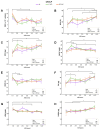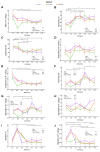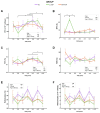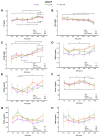Long-Term Study of Physical, Haematological, and Biochemical Parameters in Cattle with Different Embryo Origins
- PMID: 40564315
- PMCID: PMC12189840
- DOI: 10.3390/ani15121763
Long-Term Study of Physical, Haematological, and Biochemical Parameters in Cattle with Different Embryo Origins
Abstract
Assisted reproductive technologies are vital in cattle breeding to improve genetic selection and productivity. While early-life differences between artificially inseminated (AI) and in vitro-produced (IVP) cattle have been studied, long-term physiological, haematological, and biochemical effects remain unclear. This observational study assessed AI and IVP cattle from 1.5 to 5 years of age to determine if early differences persist. IVP cattle were produced after the transfer of the embryo produced by supplementing (RF-IVP group) or not supplementing (C-IVP) the embryo culture with oviductal and uterine fluids. Physical evaluations showed body mass index increased until 3.5 years, while temperature and respiratory rate declined with age, with no significant differences between AI and IVP groups. Haematological analysis revealed age-related changes, including decreased red and white blood cell counts and increased mean corpuscular volume and haemoglobin. AI cattle had higher white blood cell counts than IVP groups. Sex significantly influenced many haematological variables. Biochemical analysis showed age-related increases in total protein, creatinine, and urea, and decreases in glucose and alkaline phosphatase. AI cattle had lower cholesterol and creatinine than IVP groups. Despite group differences, all values remained within normal ranges. Sex affected albumin, cholesterol, triglycerides, and creatine kinase. This study provides the first long-term haematological and biochemical reference values for cattle from different reproductive methods, showing that age is the main influencing factor and supporting IVP cattle as a viable alternative to AI in breeding programs.
Keywords: assisted reproductive technologies; biochemical profile; cattle; haematological profile; long-term study.
Conflict of interest statement
The authors declare no conflicts of interest.
Figures






Similar articles
-
Restrictive versus liberal red blood cell transfusion strategies for people with haematological malignancies treated with intensive chemotherapy or radiotherapy, or both, with or without haematopoietic stem cell support.Cochrane Database Syst Rev. 2017 Jan 27;1(1):CD011305. doi: 10.1002/14651858.CD011305.pub2. Cochrane Database Syst Rev. 2017. Update in: Cochrane Database Syst Rev. 2024 May 23;5:CD011305. doi: 10.1002/14651858.CD011305.pub3. PMID: 28128441 Free PMC article. Updated.
-
Physical exercise training interventions for children and young adults during and after treatment for childhood cancer.Cochrane Database Syst Rev. 2016 Mar 31;3(3):CD008796. doi: 10.1002/14651858.CD008796.pub3. Cochrane Database Syst Rev. 2016. PMID: 27030386 Free PMC article.
-
Prophylactic platelet transfusion for prevention of bleeding in patients with haematological disorders after chemotherapy and stem cell transplantation.Cochrane Database Syst Rev. 2012 May 16;2012(5):CD004269. doi: 10.1002/14651858.CD004269.pub3. Cochrane Database Syst Rev. 2012. PMID: 22592695 Free PMC article.
-
Systemic pharmacological treatments for chronic plaque psoriasis: a network meta-analysis.Cochrane Database Syst Rev. 2017 Dec 22;12(12):CD011535. doi: 10.1002/14651858.CD011535.pub2. Cochrane Database Syst Rev. 2017. Update in: Cochrane Database Syst Rev. 2020 Jan 9;1:CD011535. doi: 10.1002/14651858.CD011535.pub3. PMID: 29271481 Free PMC article. Updated.
-
Systemic pharmacological treatments for chronic plaque psoriasis: a network meta-analysis.Cochrane Database Syst Rev. 2021 Apr 19;4(4):CD011535. doi: 10.1002/14651858.CD011535.pub4. Cochrane Database Syst Rev. 2021. Update in: Cochrane Database Syst Rev. 2022 May 23;5:CD011535. doi: 10.1002/14651858.CD011535.pub5. PMID: 33871055 Free PMC article. Updated.
References
-
- Berean D., Bogdan L.M., Opris P., Cimpean R. Economical Implications and the Impact of Gonadotropin-Releasing Hormone Administration at the Time of Artificial Insemination in Cows Raised in the Extensive System in North Romania. Front. Vet. Sci. 2023;10:1167387. doi: 10.3389/fvets.2023.1167387. - DOI - PMC - PubMed
-
- Viana J.H.M. 2022 Statistics of Embryo Production and Transfer in Domestic Farm Animals. Embryo Technol. Newsl. 2023;41:22–40.
LinkOut - more resources
Full Text Sources

